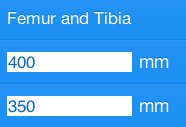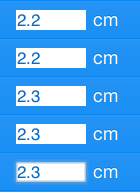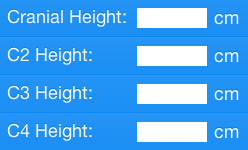Besides the inner workings of Anthropomotron, I am also adding new features readily visible to anthropologists. Adult stature estimation gets some new neighbors as I add juvenile stature estimation and full body stature estimation. Juvenile stature estimation also turns long bone lengths to an estimated stature using findings from two teams of researchers. Full body estimation takes the height of 29 bones that form an individual’s standing height. It is the best estimate since it involves direct measurements of what constitutes stature. At first I thought adding this feature would be an easy undertaking since the procedure simply adds everything together plus a little extra to account for the lost fleshy bits. Implementing the calculation has provided several unexpected challenges!
For example, there is the issue of paired limbs. The published procedure is that if both femora, tibiae, or feet are available, the average is taken (Raxter et al. 2006, 2007), so that is an additional calculation for each pair. Anthropomotron has to know if both bones in a pair are present and average them for the final calculation, or if only one is present, to use that value.
I also have to account for the work of two separate sets of researchers. The oldest commonly used method is by Fully (1956), but Raxter and colleagues (2006, 2007) made improvements. I think both have value (and it is interesting to compare their results) so I am implementing both methods. Raxter and colleagues’ actually has an option to account for age in the estimate, so there has to be a separate set of calculations for that area.
The sheer number of measurements also needed some changes to the interface. In other sections of Anthropomotron, the placeholder describes what should go in a given text box. For example:

When the user enters the measurements, the placeholder is overwritten. The negative of this display is that the user loses information on the purpose of the text box. On the positive side, some clutter is removed (this push and pull seems to be the crux of a lot of device design issues, such as the iOS7 redesign). In Anthropomotron, usually there is text nearby to reinforce what the text boxes are for:

{ Oh yeah. }
With full body estimation, there is no such reinforcement:

{ Um, where was I? }
To fix this issue, I removed the placeholder and placed a label to the left of each text box. Now CSS tweaking made the text wrap properly for longer labels and it all should fit on a vertical iPhone screen.

{ Ah, yes. }
This looks so good that I considered going back to redesign all of the other text boxes, but I quickly talked myself out of it. While the full body measurement labels are static, in many of the other estimation modes, the labels will have to change with what options are selected. Since there is no actual issue to be fixed, I will leave them be.
While adding full body estimation (a much requested feature) is getting more involved than I had planned, it will add greatly to Anthropomotron’s usefulness. I plan to get the section running and release version 1.6. Then, I feel it is time to get drawing again!
1 thought on “Hood Ornaments”